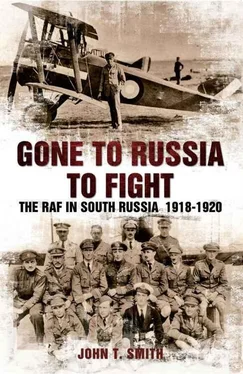The squadron personnel, though not filled with enthusiasm, proved very adaptable and the unit was soon able to fend for itself. Petrol was obtained from the oil fields at Baku and was of excellent quality. Rations and fuel were purchased locally, the meat ration on the ‘hoof’ to be ‘prepared by the squadron’. [9]
The aircraft 221 had brought to Russia were DH9s. These are powered by liquid-cooled engines. It proved to be almost impossible to start the engines in the prevailing conditions at Petrovsk:
The difficulties with the engines owing to the damp and cold were very great. The united efforts of the squadron for an hour or more were often necessary to get one engine started. Hot water poured into one end of the circulating system froze before it reached the other end. [10]
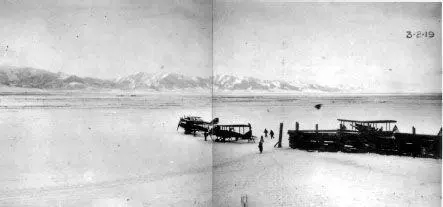
The airfield at Petrovsk. In the background are the Caucasus Mountains.
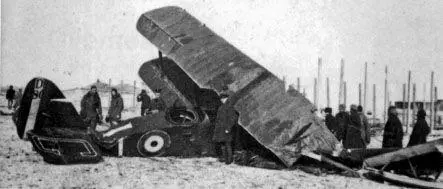
DH9 D2803, which crashed in January 1919 at Petrovsk.
Major Andrews had brought one Bentley-engined Sopwith Camel with him for his own use. The air-cooled Bentley engine gave no problems, either in starting or running.
Over the coming months, the airfield at Petrovsk was improved with the construction of several hangars, using local and squadron labour. This improved conditions for the airmen and promoted the serviceability of the aircraft. The living conditions for the squadron were still grim, however, as Knock recorded:
18/1/19 No joke trying to keep warm. Big log stove going in quarters and all available clothing used with blankets on bed. Still cold… Have to break ice in a tub outside to get wash and water in mornings. Envy officers with leather flying kits to keep warm! What a country! Plenty of insects in these quarters. Big fellows, like paddle steamers! Bite like Hades, but too cold to get out once they start, so endure. [11]
By the end of the month, in spite of the conditions, the first contingent of 221 Squadron was established at Petrovsk and the rest of the squadron aircraft and personnel were beginning to arrive.
One of the main tasks of the squadron was the support of the British Naval ships on the Caspian, but the Red naval ships were frozen in their port at Astrakhan and the Navy could not get at them. The DH9s did not have the range to bomb Astrakhan from Petrovsk. At the end of the month, Knock wrote in his diary:
28/1/19 Most machines assembled and in flying order. Am returned to duty as an armourer. Appears there is real work ahead. Capts. Grigson and Gayford make crash landing in a nine and write it off. Neither hurt. Very glad. Both popular officers. [12]
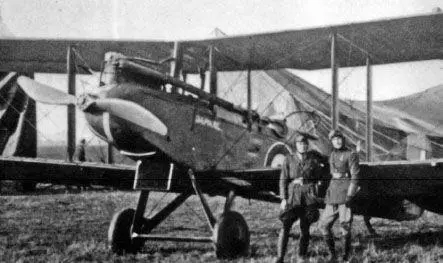
Right: Lieutenant O. R. Gayford. Left: Captain J. W. B. Grigson. The DH9 in the background is 2803, one of the aircraft transported to Petrovsk.
This was aircraft number D2803. Lieutenant L. H. Kemp arrived with one of the later groups of officers for 221 Squadron. He described his arrival at Batum:
We weren’t allowed to come into the harbour. The senior naval officer ordered us to anchor 3 miles out but during the night a terrific storm broke out and our anchor chain broke and so we were adrift. We were adrift all night. What happened eventually I don’t know. We eventually did get another anchor and in the meantime a lot of damage was done and we lost 2 aeroplanes. We lost several lorries and it was remarkable that we didn’t lose any of the men because they were sleeping in those lorries. Eventually we did get into the harbour and we tied up there. [13]
Commodore Norris returned during January, after his accident, to command the Royal Navy contingent. He had asked for twelve Coastal Motor Boats to be sent by rail overland from the Black Sea and these also started to arrive in January. The CMBs were small, fast torpedo-carrying boats built by Thornycroft Ltd. They were forty feet long and weighed 4.35 tons; with a 250-horsepower petrol engine, they had a top speed of 33.5 knots. Although they were quite small, the Coastal Motor Boats carried one torpedo and twin machine-guns. The SS Alader Youssanoff was converted into a seaplane carrier for two Short 184 seaplanes when they arrived. In addition, the Sergie and Edinburgh Castle were converted to carry two CMBs each.

HMS Alader Youssanoff , with two of 266 Squadron’s Short 184s on the foredeck.
During the month, A Flight from 17 Squadron had also become established at Batum. The squadron was based at an old Turkish airfield outside the port. Six DH9s had been sent and the flight was in the process of rigging the aircraft and settling in.
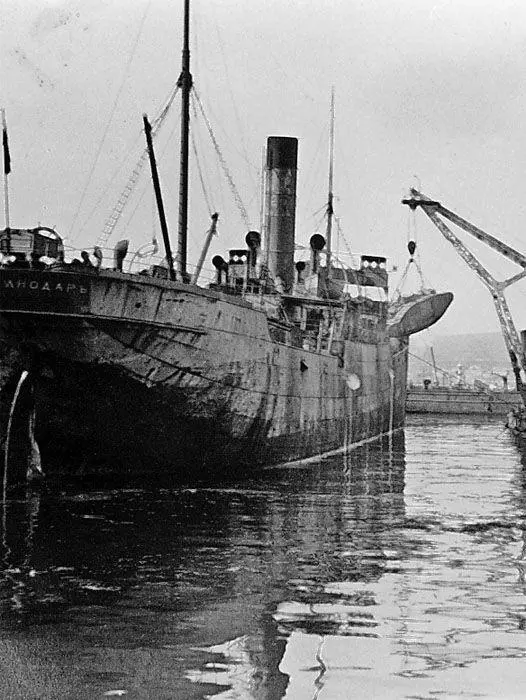
Detail of picture here.
CHAPTER SIX
FEBRUARY 1919
General Wrangel continued the White advance against the Red 11th Army during February. Grozni, the capital of Chechnia, was captured on 5 February. This allowed a join-up with the Terek Cossacks and provided a rail link between Ekaterinodar and Petrovsk, although the rail line running along the foothills of the Caucasus Mountains was never completely safe. Very few of the Red forces managed to retreat to Astrakhan or Tsaritsin. The Volunteer Army took over 50,000 prisoners; a complete Red Army Group had been destroyed. On 15 February, Krasnov, the leader of the Don Cossacks, was forced out of office because of his backing for the Germans and replaced as Ataman by General Bogaevsky. In 1947, Krasnov was hanged in Moscow as a Nazi collaborator.
During February, Lieutenant General Briggs replaced General Poole in command of the British Mission. The Armed Forces of South Russia had established their headquarters at Ekaterinodar under the control of General Denikin. Alongside this, the British established their HQ. General Briggs brought with him the first small amounts of British military aid. On 23 February, the officer who was to command the RAF in south Russia arrived in Novorossisk. This was Major, Acting Colonel, A. C. Maund. He had joined the Canadian infantry at the start of the First World War and transferred to the RFC in 1916. He had been in Russia at the time of the Revolution, as part of the mission to aid the Russians. While with this mission, he had taken part in the fighting on the Eastern Front against the Germans, flying in a BE2E. Later, he had been transferred to Archangel to command the air component of the British intervention in north Russia. It was because of his extensive experiences in Russia that Maund had been chosen to command the RAF in south Russia. He established the RAF HQ alongside the Army HQ at Ekaterinodar. There have been several derogatory descriptions made of Maund during his time in south Russia; perhaps the best that could be said was that he was an efficient staff officer rather than a leader of men.
Ekaterinodar was a large provincial Russian town on the east bank of the Kuban River. There were docks along the river, which gave access to the Black Sea through the Sea of Azov. The town had been involved in the export of agricultural produce from the rich north Caucasus area. It was also the capital city and centre for the Kuban Cossacks.
Читать дальше
